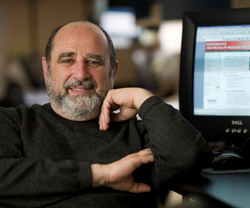 |
Simon Sherman, Ph.D. |
NOTE: This profile is part of a series highlighting the 23 researchers who were named UNMC Distinguished Scientists or New Investigators for 2008. Each of these researchers will be profiled in UNMC Today leading up to a March 16 ceremony to recognize their achievements.
- Name: Simon Sherman, Ph.D.
- Title: Professor in the Eppley Institute
- Joined UNMC: 1992
- Hometown: Minsk, Belarus
Describe your research in laymen terms, please.
There are several projects ongoing in my laboratory, ranging from basic science (such as protein folding) to applied science (such as studies of the structure-function relationship in peptide molecules). Also, I recently became interested in the mathematical modeling of cancer development and cancer risk factors in aging.
What led you to pursue this area of research?
My basic education and training are in physics and mathematics. I assumed that my background would allow me to contribute mainly in the basic and applied sciences. However, not so long ago, my wife was diagnosed with breast cancer two times. On the other hand, my mother-in-law could live for almost 100 years without any cancer. I became puzzled why some people get cancer, even at a relatively young age, while other people live long, healthy lives.
How do you see your research contributing to science?
Aging and the development of cancer are tightly dependent events that are catalyzed by various risk factors. The better understanding of their relationships is a key to solving the mystery of cancer. Recently, I (along with two researchers from my laboratory) have shown that mathematically the problem of age distribution of cancer belongs to the category of the so called “ill-posed” or “incorrectly-posed” problems and cannot be solved by the traditionally used approaches. (In January of 2009, our notes on this subject were published in a high ranking journal, Cancer Research.) Therefore, we are now working on the development of new mathematical approaches for solving this problem.
What is your hope for the next generation of scientists?
It is my hope that the next generation of scientists is able to unlock the mysteries of cancer.
Why did you become a scientist?
At a young age, I had dreamed of being a pilot or astronaut, but between the ages of 17 and 21, I had to work as a laborer, technician and engineer. Finally, I came to the conclusion that science is the best way to satisfy my natural curiosity.
Beyond grant funding, how do you measure success?
I consider it a success when the unformulated is formulated, the unsolved is solved, and the undiscovered is discovered. In other words, I feel I have made an achievement when I complete something that has not been done before.
What would you tell a student interested in a research career?
Be dedicated to science and “look into the root” of a problem.
Do you have a hero/role model? If so, what do you admire most about this person?
No, I do not have a hero.
Tell us about your family and hobbies outside of the lab.
My wife, Lyuba, has always encouraged me to be better. Recently our two sons, Vitaly and Alex, enlarged our family by marrying. We are pleased that our family will continue to grow.
Outside the lab, I love to go for walks with my dog.
List three things few people know about you.
- I was born in Germany but I am not a German;
- I grew up, lived and worked in Russia but I am not a Russian; and
- I arrived as a refugee in the United States and I am an American.